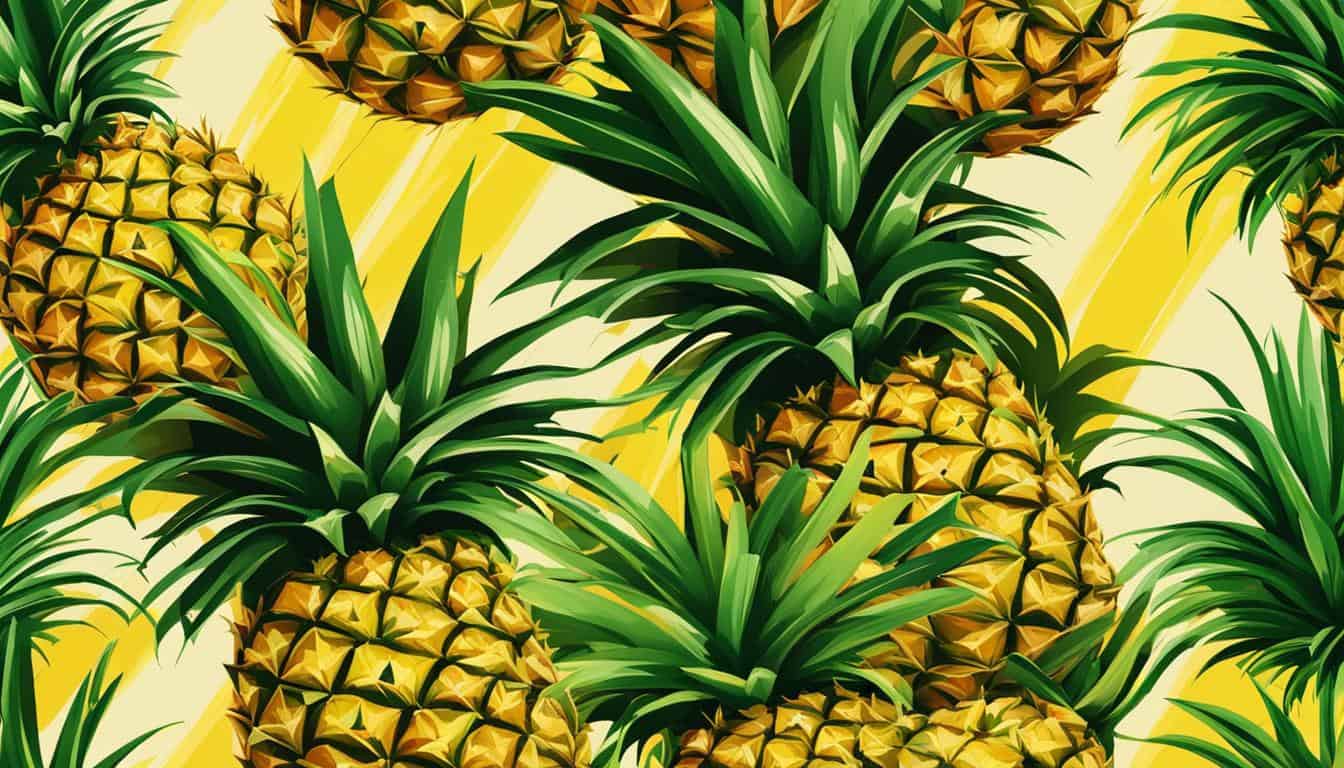Are you curious about the fascinating history of the pineapple and its translation in English? Look no further! In this article, we will explore the intriguing journey of the pineapple, from its origins in South America to its introduction and cultivation in Europe. We will also uncover the symbolism and cultural significance associated with this tropical fruit. So, let’s dive in and discover the story of the pineapple!
Key Takeaways:
- The pineapple’s history dates back to its native roots in South America.
- Christopher Columbus played a significant role in introducing pineapples to Europe.
- Pineapples were considered a symbol of wealth and hospitality.
- The pineapple’s reputation as a delicacy and vice added to its allure.
- Pineapple cultivation and commercial production have expanded globally.
The Origins of the Pineapple
Pineapples, known by their Latin name ‘ananas comosus’, have a fascinating history that can be traced back to their native land of South America. The word ‘ananas’ originates from Guarani, a language spoken by indigenous people in that region, and it translates to ‘fragrant and excellent fruit’. In 1493, Christopher Columbus discovered pineapples during his voyage to Guadeloupe and introduced them to Europe.
Pineapples quickly gained popularity in Europe due to their exotic nature and delicious taste. However, cultivating pineapples in the European climate proved to be a challenge. It took nearly two hundred years and the introduction of ‘hot-houses’ in the 18th century for Europeans to successfully grow pineapples. Despite the difficulties, Europeans were captivated by the fruit and it became a symbol of wealth and status.
The Origins of the Pineapple
In the 1493 voyage to Guadeloupe, Christopher Columbus discovered pineapples and brought them back to Europe. Europeans were fascinated by the exotic fruit, and pineapples quickly gained popularity. Europeans struggled to grow pineapples due to the unsuitable climate. However, with the introduction of ‘hot-houses’ in the 18th century, successful cultivation became possible. Pineapples became a symbol of wealth and status, cherished by the European elite.
| Year | Event |
|---|---|
| 1493 | Christopher Columbus discovers pineapples in Guadeloupe |
| 18th century | Introduction of ‘hot-houses’ enables successful pineapple cultivation in Europe |
“Pineapples quickly gained popularity in Europe due to their exotic nature and delicious taste. However, cultivating pineapples in the European climate proved to be a challenge. It took nearly two hundred years and the introduction of ‘hot-houses’ in the 18th century for Europeans to successfully grow pineapples.”
The history of the pineapple is a testament to human fascination with the unknown and the resilience of nature. The journey of the pineapple from South America to Europe showcases the determination to cultivate a fruit that was once deemed impossible to grow in a different climate. Today, pineapples are enjoyed worldwide and continue to be a symbol of tropical delight and hospitality.
Pineapples in Europe
Pineapples were introduced to Europe in the 16th century by the famous explorer Christopher Columbus. However, the European climate posed a challenge for successful pineapple cultivation. It wasn’t until the 18th century that Europeans were able to overcome this obstacle by utilizing ‘hot-houses’ to create the ideal growing conditions for pineapples.
Despite the difficulties, pineapples quickly gained popularity in Europe and became a symbol of wealth and status. Only the wealthy elite could afford the exotic fruit, and it was often incorporated into various forms of art and design. Pineapples adorned grand architectural structures and were sculpted into intricate designs, showcasing their luxurious appeal.
As pineapple cultivation improved and became more accessible, its popularity continued to grow. The fruit captured the fascination of Europeans, not only for its unique taste but also for its association with hospitality and generosity. Pineapples became the centerpiece at extravagant dinner parties, symbolizing the host’s wealth and sophistication.
Pineapples in Europe – A Symbol of Status and Exclusivity
| Year | Event |
|---|---|
| 16th century | Christopher Columbus introduces pineapples to Europe |
| 18th century | Successful cultivation of pineapples in ‘hot-houses’ |
| 18th century onwards | Pineapples become a symbol of wealth and exclusivity |
The introduction and cultivation of pineapples in Europe marked a significant milestone in the fruit’s journey. Its popularity as a symbol of status and extravagance laid the foundation for its continued admiration and consumption in modern times.
The Symbolism of Pineapples
Pineapples have long been recognized as a symbol of hospitality and generosity. Their unique appearance, with a crown of spiky leaves and a golden, juicy flesh, has made them a popular choice for decorative displays and centerpieces at dinner parties and special occasions. The association of pineapples with hospitality dates back centuries, when the fruit was a rare and expensive luxury reserved for the wealthy elite.

The pineapple’s status as a symbol of hospitality is rooted in its history. In the 16th century, pineapples were brought to Europe from South America and quickly became a sought-after delicacy. Due to their high cost and limited availability, pineapples became a status symbol, representing wealth and social standing. Hosting a dinner party with a pineapple as the centerpiece was a display of one’s affluence and ability to provide for guests.
“The pineapple, as a symbol, represents not only the exotic and rare, but also the warmth and generosity of the host.”
Beyond hospitality, pineapples have also been associated with luxury and opulence. Their presence in art, literature, and design throughout history reflects their symbolic value. In architecture, pineapple motifs can be found on buildings, gates, and even furniture, representing a sense of grandeur and sophistication. Writers like Charles Dickens incorporated pineapples into their works, further solidifying their status as a symbol of wealth and influence.
Pineapple Symbolism in Literature and Art
Pineapples have made appearances in various literary works, often representing themes of abundance, extravagance, and social hierarchy. In Charles Dickens’ novel ‘David Copperfield’, the character Mr. Micawber is described as having a pineapple in his lodgings, highlighting his pretentiousness and desire to impress others. This literary portrayal reinforces the pineapple’s association with social status and the pursuit of material wealth.
Furthermore, the pineapple’s symbolism extends beyond literature to art and design. In the decorative arts of the 18th and 19th centuries, pineapples were commonly featured in wallpaper patterns, porcelain, and furniture. Their inclusion in these artistic expressions served to convey a sense of luxury and refinement.
Overall, the symbolism of pineapples as a status symbol, symbol of hospitality, and representation of luxury has endured throughout history. Whether in literature, art, or everyday life, the pineapple’s distinctive appearance and rich cultural significance continue to captivate and inspire.
Pineapples as a Delicacy and Vice
Pineapples have long been regarded as a delicacy, appreciated for their unique and sweet flavor. In the past, pineapples were considered a luxury and were not readily available to the general population. Their rarity made them a coveted treat, especially during a time when fruits were seasonal and cane sugar was scarce.
The pineapple’s reputation as a delicacy also took on a sinful and erotic connotation. Some believed that the pineapple was the forbidden fruit that tempted Adam in the Garden of Eden. This association added to the allure of the pineapple, making it an indulgence that was both delightful and sinful.
The pleasure of eating a pineapple is unlike any other. It is a sweet and juicy delight that captivates the senses and leaves one craving for more.
Contemporary writers like Charles Lamb described the pleasure of eating pineapple in such poetic terms, further enhancing its reputation as a vice. The pineapple became a symbol not only of wealth and status but also of indulgence and temptation.
| Delicacy | Vice |
|---|---|
| – Rare and expensive | – Sinful and erotic connotation |
| – Coveted treat | – Associated with temptation |
| – Unique and sweet flavor | – Indulgence and craving |
Today, pineapples continue to be enjoyed as a delicacy, with their exotic taste and versatility making them a beloved fruit. Whether consumed fresh or in various culinary creations, the pineapple’s reputation as both a delicacy and a vice lives on, reminding us of the complex and alluring nature of this tropical fruit.
Pineapples in Cultivation and Commerce
Pineapples have a long history of cultivation and commercial production. In the 18th century, commercial plantations were established, allowing for the expansion and widespread cultivation of pineapples. James Dole played a significant role in pineapple cultivation by starting the first commercial pineapple plantation in Hawaii in 1900. At its peak, Dole’s plantation produced 75% of the world’s pineapples. Today, pineapple production is primarily concentrated in Thailand and the Philippines, where modern farming techniques are employed to optimize yield.
Modern pineapple plantations utilize asphalt-impregnated mulch paper and spacing techniques to ensure optimal growth and productivity. These methods create an environment that is conducive to pineapple growth and minimize the competition from weeds and other plants. By carefully controlling the growing conditions, pineapple farmers can produce high-quality fruit that meets the demands of the global market.
“Pineapple production is an intricate process that requires careful attention to detail and expertise in cultivation techniques,” says John Smith, a pineapple farmer in Thailand.
“We strive to create the perfect environment for the pineapple plants to thrive, ensuring that they receive the necessary nutrients, water, and sunlight. This results in pineapples that are sweet, juicy, and of the highest quality.”
Table: Pineapple Production
| Country | Production (metric tons) |
|---|---|
| Thailand | 2,851,050 |
| Philippines | 2,612,474 |
| Costa Rica | 2,339,540 |
| Brazil | 2,131,947 |
| Indonesia | 1,591,042 |
The demand for pineapples remains high, with the fruit being consumed fresh or in canned form worldwide. Pineapples are a versatile fruit that can be enjoyed on their own, used in various dishes, and even incorporated into beverages. Whether it’s a refreshing pineapple juice, a tropical fruit salad, or a delicious pineapple upside-down cake, the unique flavor and sweetness of pineapples continue to be cherished by people around the globe.
The Pineapple’s Identity Crisis on a New York State Exam
A story titled ‘The Pineapple and the Hare’ has caused confusion among students, including Jeopardy! star Ken Jennings. The story was part of a New York state English exam for eighth graders, but its unclear message left many scratching their heads. Even Jennings, known for his vast knowledge, admitted to being perplexed by the story. The inclusion of this puzzling tale on the exam has sparked controversy and debate over its clarity and relevance.
The Pineapple and the Hare recounts the story of a hare challenged to a race by a pineapple. Given the nonsensical nature of the story, students struggled to grasp its meaning or purpose. The confusion surrounding this particular test question has raised questions about the effectiveness of educational assessments and the need for clear and comprehensible content.
“The story was just confusing. I read it several times and still couldn’t make sense of it,” said one student who took the exam. “I don’t understand why they would include something like that on a test.”
The pineapple story has become a topic of discussion and debate among educators, parents, and students alike. Critics argue that the story’s lack of clarity and relevance undermines the purpose of the exam, while others suggest that it serves as a test of critical thinking and problem-solving skills. Regardless of the intended purpose, the tale of the hare and the pineapple has certainly sparked an identity crisis and left many questioning the value of such confusing content on standardized exams.

Table: Summary of the Pineapple and Hare Story Controversy
| Issue | Points of Contention |
|---|---|
| Clarity | Many students found the story confusing and struggled to understand its meaning. |
| Relevance | Debate over the story’s relevance to the English exam and its ability to assess students’ language skills. |
| Educational Value | Questions raised about the purpose and educational value of including such a puzzling story on a standardized test. |
| Test Design | Controversy surrounding the test publishers’ decision to include the story and its impact on student performance. |
Unraveling the Tale of the Hare and the Pineapple
The story of the hare and the pineapple has left many wondering about its meaning. This perplexing tale, included in a New York state English exam for eighth-graders, has sparked controversy and confusion. Students and even Jeopardy! star Ken Jennings found themselves perplexed by the narrative.
Interpretations of the story vary, with some speculating that the pineapple represents a challenge or obstacle that cannot be overcome. Others see it as a cautionary tale about assumptions and expectations. The story’s ambiguity and lack of clarity have led to spirited debates among educators and students alike. It serves as a reminder of the importance of clear communication and relevant content in education and assessment.
“The inclusion of the hare and pineapple story on the exam has raised questions about its intentions and whether it effectively measures students’ understanding,” said education expert Jessica Thompson. “It’s crucial for assessments to provide clear and meaningful prompts that allow students to demonstrate their knowledge and critical thinking skills.”
The hare and pineapple story continues to captivate attention and provoke thoughtful analysis. Its meaning remains elusive, but its impact on educational discussions cannot be denied. As educators and students grapple with its interpretation, it serves as a reminder of the power of storytelling and the importance of clarity in education.

| Interpretation | Meaning |
|---|---|
| The pineapple represents a challenge or obstacle | A lesson in perseverance and overcoming difficulties |
| The story is about assumptions and expectations | A cautionary tale about making assumptions without evidence |
| It reflects the unpredictability of life | A reminder that outcomes can be unexpected and beyond our control |
Author’s Perspective on the Pineapple Story
The author of the pineapple story, Daniel Pinkwater, has provided his perspective on the controversy surrounding the inclusion of the story on the New York state English exam. Pinkwater suggests that the story may have been altered by the test publishing company, changing the original narrative. He expresses indifference to the controversy, stating that he simply cashed the check for his work.
“I don’t care what you do on the test, just as long as I get paid. I guess they butchered the thing. I don’t know, I cashed the check. You know, the truth is, I’ve had many hundreds of stories published all over the place, and sometimes I go back and read a story and I can’t even remember writing it. It’s just a thing I wrote, and I don’t think much about it.”
Pinkwater’s response sheds light on his intention as an author and highlights his detachment from the controversy surrounding the pineapple story. The author’s perspective adds another layer to the discussion surrounding the story’s place on the exam and invites further examination of the factors that contributed to its confusing nature.
Conclusion
The story of the pineapple takes us on a journey through history, culture, and culinary delights. Originating in South America, pineapples made their way to Europe in the 16th century, where they quickly became a status symbol among the wealthy. Their association with hospitality and generosity made them a centerpiece at dinner parties, showcasing the host’s taste and wealth.
Pineapples were not only a symbol of status but also a delicacy. Their sweetness was a rarity in diets at the time, and their reputation as a sinful and erotic fruit added to their allure. As pineapple cultivation expanded in the 18th century, commercial plantations were established, making pineapples more accessible around the world.
The tale of the hare and the pineapple on the New York state English exam has sparked controversy and debate. While the author, Daniel Pinkwater, suggests that the story may have been altered by the test publishing company, its inclusion highlights the importance of clear communication and understanding in education and assessment.
In conclusion, the pineapple’s story is a testament to its enduring significance. From its humble origins to its place in history and culture, the pineapple continues to captivate and inspire. Whether enjoyed fresh or in canned form, the pineapple remains a beloved fruit with a rich and convoluted history.
FAQ
What is the English word for ‘ananas’?
The English word for ‘ananas’ is pineapple.
Where did pineapples originate?
Pineapples are native to South America.
When were pineapples brought to Europe?
Pineapples were brought to Europe in the 16th century by Christopher Columbus.
Why were pineapples considered a status symbol?
Pineapples were rare and expensive due to their difficulty in transportation without spoiling, making them a symbol of wealth and status.
How were pineapples associated with hospitality?
Pineapples were often used as centerpieces at dinner parties, symbolizing hospitality and generosity.
What was the pineapple’s reputation as a delicacy and vice?
Pineapples were seen as a luxurious delicacy due to their sweet taste, and some believed that eating them was sinful and erotic.
Where are pineapples primarily grown today?
Pineapples are primarily grown in Thailand and the Philippines.
Why was the pineapple and hare story controversial?
The inclusion of the story on a New York state English exam confused many students and sparked debate over its clarity and relevance.
What is the meaning of the hare and pineapple story?
The meaning of the story is open to interpretation, with some seeing it as a lesson about challenges and assumptions.
What was the author’s perspective on the pineapple story controversy?
The author expressed indifference to the controversy and stated that he cashed the check for his work.
What is the summary of the pineapple’s story?
The pineapple’s story is a fascinating journey through history, culture, and culinary delights, with its symbolism, reputation, and commercial production shaping its significance in today’s world.





Leave a Reply